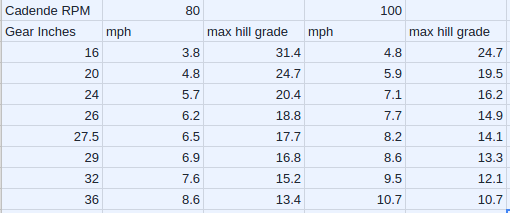Whew!
Now I’m out of popcorn, so I feel obligated to post something.
Uh…
I have no ammo from Physics class, since I never took one. All my physics knowledge comes from real-world experiences, and watching a lot of sports and circus. Some things are obvious enough, while others are subtle and probably invisible to someone not familiar with the activity.
Mr. Engineer, I know you’re riding on some hills because Manhattan and the Bronx are not flat. But you’re a relatively new rider, and if your concentration has been on covering distance, you probably haven’t “studied” uphill riding much yet. What is your engineering background, btw? We get all sorts of interesting people in unicycling, with interesting skills and knowledge.
Tom Holub has a ton of hands-on experience with uphill riding, and I’m pretty sure he’s right about a bicycle being basically the more efficient vehicle for going uphill under any conditions. As you can see he likes to nerd-out on some of these topics and not yield while he still thinks he can explain something.
Unicycles only have one wheel. They do not track in a straight line, even if you try really hard. An efficient climber learns how to minimize this, but doing so involves expending energy with each pedal “step” to keep the wheel pointed straight. I pendulum my non-seat-holding arm as part of that. On a bike you only need to make some tiny steering inputs to keep yourself pointed in the most efficient direction up the hill.
Engineer’s descriptions of riding up the hills seem to involve a constant spin being maintained. Naturally this would be the most efficient way to ride, but your spin starts to break down as the slope gets steeper. As you hit a hill with speed, you can spin into it. but if it gets steep, that spin will slow (unless you have a little wheel), and after that you will be “lugging”, with power pushes alternating between little gaps of power as the pedals pass through vertical. As it gets steeper, it becomes more of a series of big pushes, that might have to include little micro-rests between steps. This is a good way to ride up a steep hill that’s long.
Anyway, all of that is pretty inefficient. Too bad we can’t downshift. 36" wheels are horrible for riding up anything steep. We only put up with them because they’re so much better than smaller wheels when the going is flat or downhill.
I’ve been to Fargo Street once, at the 2014 CA Muni Weekend. I brought my 24" Miyata with 125mm cranks (a “Track” uni), and my 26" Roger Davies carbon Muni with 150mm cranks. I’m not sure which one I ended up using, but I think it was the Muni because it’s really light, and had more leverage. I couldn’t get very far going straight up (and I consider myself a pretty good uphiller), and switched to zig-zagging to avoid a dismount. I did eventually stop, more than once, to “replenish oxygen” before I made it to the top. 
We don’t really get to spin “efficiently” up things that are considered steep, unless we’re riding relatively small wheels. If I were to seriously challenge Fargo Street, with conditioning and training, I think I might opt for a very light 700c wheel with “medium” cranks. Medium means I think I’d end up with something not real long, and definitely not very short. For that street.
The guy who has the unicycle record (far as I’m aware) for Mt. Diablo, Greg Drummond I think was his name, used a Coker that was super stripped down and lightened. I think he went crazy with a drill on it, though I haven’t seen the uni myself. Coker (or any other 36") tires are notoriously heavy, but I think he preferred that to a smaller wheel. I have also ridden a 36" up Mt. Diablo. The higher half of the ride is mostly fairly steep, and much of it is accomplished half a revolution at a time. Then there’s that last bit, which is somewhere north of 20% and I could only make it up that a little bit at a time (many stops).
Anyway, the key points I guess I’m making are that unicycles generally don’t get “spun” up long slopes that are steep; it usually ends up being a series of pushes; how hard depending on the grade. Also that, because unicycles don’t go in a straight line, a unicyclist has to use a bunch of additional energy just to try to keep an efficient line.
Also, with my armchair physics knowledge, every time people apply “textbook” physics arguments to unicycles here, they inevitably seem to make assumptions or leave out small details that aren’t actually that small. All the mechanics of riding a unicycle must be hellishly messy in mathematical format.
Anyway, thanks for that fascinating discussion, and feel free to pick my post apart now. I am now armed with a bag of M&M’s! 




